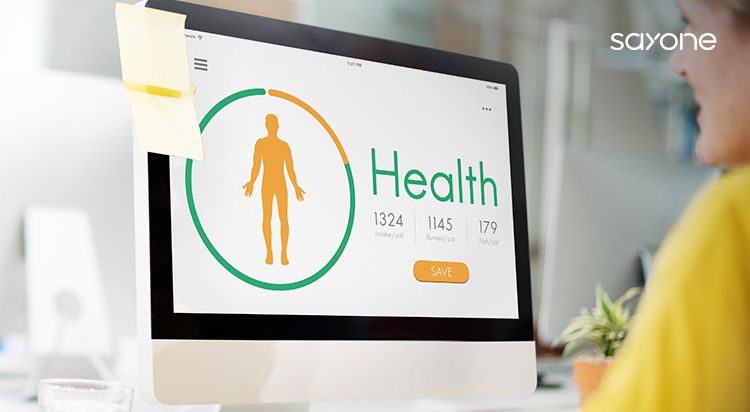
Subscribe to our Blog
We're committed to your privacy. SayOne uses the information you provide to us to contact you about our relevant content, products, and services. check out our privacy policy.

Akhil SundarNovember 7, 20249 min read

Generating table of contents...
Healthcare web applications have become essential to modern healthcare delivery, improving patient care and operational efficiency. These digital solutions include a wide range of tools, from electronic health records and telemedicine platforms to patient portals and clinical decision support systems.
Their importance has grown markedly in recent years. The use of healthcare web applications has increased notably.
These applications provide many advantages to healthcare providers and patients. They improve access to medical services, especially for those in remote areas or with mobility issues.
What makes a healthcare application transform from a mere digital tool into a catalyst for change? The answer lies in what behavioral economists call the "threshold of adoption."
The global healthcare IT market isn't just growing - it's exploding from $394.6 billion toward a projected $974.5 billion by 2027
As the healthcare industry continues to change, web applications will play an increasingly important role in improving patient care, operational efficiency, and driving innovation, making them a necessary part of modern healthcare delivery.
Healthcare web application development involves creating specialized software solutions that operate through web browsers to serve healthcare providers, patients, and medical institutions.
These applications streamline medical services by digitizing various healthcare processes and enabling remote access to medical information.
These apps make healthcare more efficient, easier to access, and involve patients more. They run on web browsers across different devices without needing installation. They aim to simplify office tasks, improve how patients and doctors talk, and keep health data safe.
Every click, every interface, every data point matters.
Consider the case of Memorial Healthcare System. Their emergency response times dropped by 30% after implementing a web-based patient management system. But here's what's fascinating: the technology wasn't the breakthrough. The breakthrough was in understanding how humans interact with medical information.
The pattern reveals itself when we look closer:
The real value isn't in the code or servers. It's in the moments when a doctor can access critical information instantly. When a patient can book an appointment without waiting on hold. And that’s why you need to switch to digital healthcare.
Healthcare web applications fall into three primary categories that serve different purposes in the medical ecosystem:
These platforms focus on presenting medical information and building brand presence. They include hospital websites, pharmaceutical catalogs, and educational resources for medical professionals and patients.
These specialized platforms enable secure interactions between healthcare stakeholders. Patient portals provide 24/7 access to personal health records and appointment scheduling, while staff portals streamline internal workflows and knowledge sharing.
These applications handle specific medical functions:
Each type serves unique needs in the healthcare sector.
Modern healthcare applications increasingly incorporate AI, IoT, and blockchain technologies to upgrade their capabilities and security.
The choice of application type depends on the specific requirements of healthcare providers, ranging from simple information websites to complex patient management systems.
These applications must comply with healthcare regulations while ensuring data security and user privacy
Initial phase which defines the core functionalities and objectives of the healthcare web application. It's where you ask: How can we make healthcare more accessible and efficient for patients and providers? The objective here is to achieve A clear understanding of the market, user needs, regulatory requirements, and a well-defined problem statement.
Outlining the product's functionality, design, and technical requirements in detail, ensuring they meet the healthcare sector's unique needs. The purpose of this stage is to discover a comprehensive product roadmap detailing market research, conceptual design, and initial scope.
Target Audience Analysis: Define primary users. Ask: Who benefits most from our app? This includes hospitals, clinics, doctors, patients, and insurance providers.
Selecting technologies that fit the app's performance, scalability, and compliance needs. Primary focus on this stage is to select a tech stack that is scalable, secure, and compliant with healthcare regulations.
Ask: How can we integrate secure data handling and access controls?
Designing a user-friendly interface and ideal user experience tailored for healthcare professionals and patients. The intended outcome of this stage is to secure Complete UX and UI designs ready for development.

The above graph shows the user journey stages that you’ll need to refer, to design your patient/staff portal application
The graph reveals three distinct user paths:
1. Patient Registration (Landing → Register → Profile → Dashboard)
2. Telemedicine Booking (Dashboard → Doctor Selection → Time Selection → Booking Confirmation)

3. Medical Records Access (Dashboard → Records → History View)
Building the app's functionality based on the approved design and technical requirements. The core intention behind this stage is a fully functional healthcare web application ready for testing.
Here is the guide on How to Create an ADA-Compliant Website
Verify that the app meets all functional, performance, security, and compliance requirements. This stage's main target is to obtain a well tested healthcare web app ready for deployment.
Read more on Web Application Testing: How to Ensure Your Website's Functionality
A live, secure, and user-friendly healthcare web application with ongoing support and enhancements is what you need at the end. To achieve this You’ll need to Deploy the app in a secure environment and ensure its ongoing functionality and compliance.
AI and ML are revolutionizing healthcare by enabling applications to analyze vast amounts of medical data. These technologies assist in diagnosing diseases, predicting patient outcomes, and automating administrative tasks.
For instance, AI can analyze medical images or suggest personalized treatment plans based on patient history, improving both accuracy and efficiency in healthcare delivery.
A growing trend is the use of generative AI in healthcare, which brings additional capabilities:
Clinical Documentation: Generative AI models can automate the creation of clinical notes, reducing the administrative burden on healthcare professionals.
Medical Record Summarization: These models can summarize complex medical records, providing doctors with concise, actionable insights.
Drug Discovery: Generative AI can simulate molecular structures, accelerating drug discovery by predicting how new drugs interact with biological systems.
IoMT connects medical devices, wearables, and sensors to healthcare systems, allowing real-time monitoring and data collection. This technology can reduce hospital visits by enabling remote patient care and improving treatment outcomes through continuous health tracking.
However, IoMT integration requires a robust infrastructure for data security and interoperability. Consider how your application will handle the influx of real-time data while maintaining compliance with privacy regulations.
Blockchain offers a secure way to manage healthcare data by creating immutable records that can be shared across different healthcare systems. This technology secures data privacy, ensures interoperability, and gives patients control over their health records.
However, blockchain implementation comes with challenges like scalability and integration with existing healthcare IT systems. Assess these factors before deciding to incorporate blockchain into your web application.
Choosing the right development partner is essential for building a successful healthcare web application. SayOne Technologies offers expertise in custom software development tailored to the healthcare sector. Contact us today to explore how we can help you build a secure, compliant, and innovative healthcare solution.

We're committed to your privacy. SayOne uses the information you provide to us to contact you about our relevant content, products, and services. check out our privacy policy.

About Author
Subject Matter Expert

We collaborate with visionary leaders on projects that focus on quality